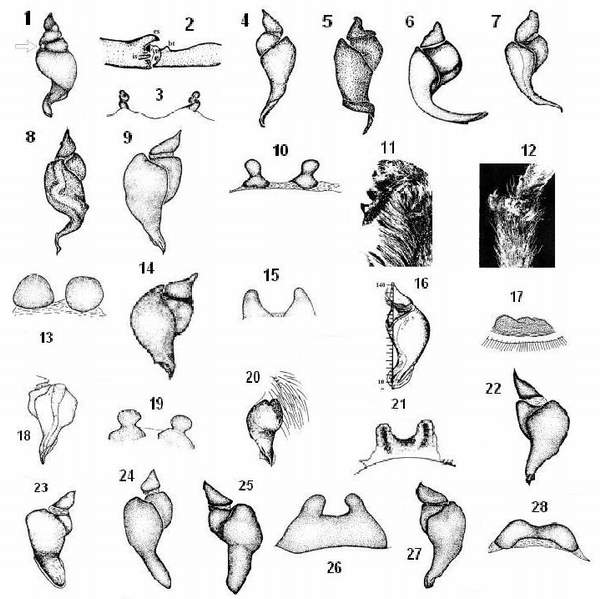Subfamily Theraphosinae (Thorell, 1870)
Identification keys of genera of Subfamily Theraphosinae
(By: Perez-Miles et al. Systematic revision and cladistic analysis of Theraphosinae (Araneae: Theraphosidae). 1996. Mygalomorph 1: 33-68)
This is a speciouse group from the New World showing high diversity in the southern region of North America, Central and South America.
Representatives of the subfamily Theraphosinae characterizes in the presence of urticating hairs of types I and/or III and/or IV. The palpal bulb has a large subtegulum, extended and with keels present. Also there're no stridulating organ between outer surface of chelicerae and the inner surface of the coxa of the palp. Both surfaces are smooth or at most with scanty hairs.
Stridulating organ between the basal segments of the palp and leg I also absent.
|
Key |
Feature |
Key or genera name |
|
1 |
Type IV urticating hairs present |
2 |
|
|
Type IV urticating hairs absent |
6 |
|
2 |
Coxa of leg I with stridulatory setae |
Grammostola |
|
|
Coxa of leg I without stridulatory setae |
3 |
|
3 |
Digitiform apophysis on the base of the tegulum (fig. 1) |
Homoeomma |
|
|
Palpal bulb without digitiform apophysis |
4 |
|
4 |
Retrolateral basal nodule on metatarsus I in males (fig. 2), metatarsus I closing between the tibial apophysis. Female with spiral spermathecae (fig. 3) |
Plesiopelma |
|
|
Metatarsus I without nodule |
5 |
|
5 |
Paraemboliс apophysis present (fig. 4) |
|
|
|
Paraemboliс apophysis absent |
Euathlus |
|
6 |
Labium with few cuspules (less than 15) |
7 |
|
|
Labium with numerous cuspules (more than 20) |
8 |
|
7 |
Palpal bulb with embolus subcylindrical (fig. 5), spiral, female with two separated spermathecal receptacles |
Melloleitaoina |
|
|
Palpal bulb with embolus subcylindrical, curved (fig. 6). Metatarsus I strongly curved, single spermathecal receptacles |
Hapalotremus |
|
8 |
Palpal bulb as in fig. 7 |
Euathlus |
|
|
Palpal bulb not as fig. 7 |
9 |
|
9 |
Palpal bulb as in fig. 8 |
Tmesiphantes |
|
|
Palpal bulb not as in fig. 8 |
10 |
|
10 |
Spiniform hairs on the retrolateral face of coxae. Type I urticating hairs present |
11 |
|
|
Retrolateral face of coxae without such spiniform hairs |
12 |
|
11 |
Stridulatory setae on the prolateral face of trochanter I |
Citharacanthus |
|
|
Stridulatory setae on the prolateral face of trochanter I absent |
Aphonopelma |
|
12 |
Palpal bulb with one keel wider than the others |
13 |
|
|
Palpal bulb with subequal keels |
14 |
|
13 |
Males without tibial apophyses, female with one fused spermathecae |
Metriopelma |
|
|
Males with two tibial apophyses and metatarsus I strongly curved |
Hapalopus |
|
14 |
Cyclosternum |
|
|
|
15 |
|
|
15 |
Embolus with bifid apex |
Schizopelma |
|
|
Embolus apex not bifid |
16 |
|
16 |
Type I urticating hair present |
17 |
|
|
Type I urticating hair absent |
29 |
|
17 |
Only one tibial apophysis, embolus corkscrew shaped (fig. 11, 12), two subspherical spermathecae (fig. 13) |
|
|
|
Two or no tibial apophyses |
18 |
|
18 |
Males without tibial apophyses, female with two spermathecae (fig. 14, 15) |
|
|
|
Female with single or two spermathecal receptaculum |
19 |
|
19 |
Female with notched spermatheca (fig. 16, 17). Males without tibial apophyses |
Sericopelma |
|
|
Males with two tibial apophyses |
20 |
|
20 |
Tibia IV of males highly incrassate, palpal bulb and spermathecae as in fig. 18 and 19 |
Eupalaestrus |
|
|
Tibia IV of male not incrassate |
21 |
|
21 |
Vitalius |
|
|
|
22 |
|
|
22 |
Stridulatory setae on the trochanter and coxa of leg I |
Phormictopus |
|
|
Stridulatory setae on trochanter or coxa of leg I, or absent |
23 |
|
23 |
Stridulatory setae only on trochanter |
24 |
|
|
Stridulatory setae only on coxa or absent |
25 |
|
24 |
Carapace with spherical foveal process |
|
|
|
Carapace without spherical foveal process |
Cyrtopholis |
|
25 |
Palpal bulb as in fig. 22 |
Lasiodora |
|
|
Palpal bulb not as in fig. 22, no stridulatory setae |
26 |
|
26 |
Femur III incrassate, palpal bulb as in fig. 23 |
Megaphobema |
|
|
Femur III not incrassate |
27 |
|
27 |
Palpal bulb as in fig. 24 |
Pamphobeteus |
|
|
Palpal bulb not as in fig. 24 |
28 |
|
28 |
Xenesthis |
|
|
|
||
|
29 |
Males without tibial apophyses, stridulatory setae absent |
|
|
|
Males with two tibial apophyses, stridulatory setae on coxa II |
